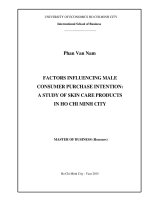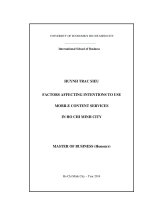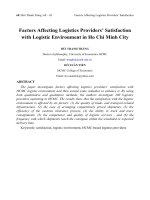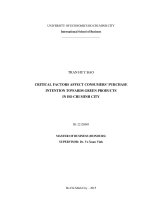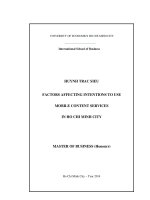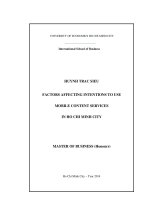Critical factors affect consumers purchase intention towards greeen products in ho chi minh city
Bạn đang xem bản rút gọn của tài liệu. Xem và tải ngay bản đầy đủ của tài liệu tại đây (568.42 KB, 90 trang )
UNIVERSITY OF ECONOMICS HO CHI MINH CITY
International School of Business
TRAN HUY BAO
CRITICAL FACTORS AFFECT CONSUMERS’ PURCHASE
INTENTION TOWARDS GREEN PRODUCTS
IN HO CHI MINH CITY
ID: 22120003
MASTER OF BUSINESS (HONOURS)
SUPERVISOR: Dr. Vo Xuan Vinh
Ho Chi Minh City – 2015
ACKNOWLEDGEMENTS
I would like to express my greatly appreciation in thanking people who helped me to
complete this thesis. Firstly, I am very grateful to my advisor, Dr. Vo Xuan Vinh, for his
valuable advices. I especially appreciate his continual support in responding, reminding, and
assisting in all aspects of this endeavor.
On the other hand, I would like to thank my colleagues, friends and classmates for their
valuable encouragement during months that I was working on this thesis. Special thanks for
people who spent their precious time with me in both pilot and main surveys.
Finally, I would like to express my heartfelt thanks to my family for their support, their
encouragement, and their faith during the time I accomplish my thesis.
2
ABSTRACT
One of the largest and the most urgent problems that the world is facing today is the
environmental pollution which both the government and civilians contribute to solve this issue.
In fact, the injurious smoke emitted by cars, buses, trucks, trains, and the wastes from factories,
namely sulphur dioxide, carbon monoxide or nitrogen oxides have been creating more bad
effects on environment. For this reason, corporations must find effective environmental
solution in reducing the pollution. Therefore, green product is one of the suitable solutions
which are applied in many countries over the world. There are also many researches about
green product studies; however, it is still rather new in Vietnam and green products have
not yet approached to Vietnamese consumers. Moreover, the corporations in Vietnam have not
had a thorough grasp of this kind of product and how consumers reach with green product.
Thus, this research needs to be profoundly supported. This paper is researched based on the
theory and the foundation from the study of Wilson King, Amran Harun, Rini Suryati Sulong
and Jaratin Lily (2014). In that, there are five factors including eco-label, green packaging,
green corporate perception, green product value and green advertisement which are
considered in order to test influence on consumers’ purchase intention. This research aims to
find out which and how factors of green product affect purchase intention and from that, give
recommendations.
By applying both qualitative and quantitative method, the data is collected through in-depth
surveys. Then, the collected data is analyzed by SPSS software. According to reliable results,
this paper proposes recommendations for corporations which want to develop green product
line.
Keywords – Purchase intention, eco-label, green packaging, green corporate perception, green
product value, green advertisement.
3
TABLE OF CONTENTS
LIST OF FIGURES............................................................................................................................................. 6
LIST OF TABLES................................................................................................................................................ 7
CHAPTER 1: INTRODUCTION....................................................................................................................... 8
1.1Research Background..................................................................................................................................... 8
1.2Research gap.................................................................................................................................................... 9
1.3Research Objectives...................................................................................................................................... 10
1.4Research scope............................................................................................................................................... 10
1.5Research structure of thesis......................................................................................................................... 11
CHAPTER 2: LITERATURE REVIEW......................................................................................................... 12
2.1 Green product.............................................................................................................................................. 12
2.2 Purchase intention....................................................................................................................................... 13
2.3 Eco - label...................................................................................................................................................... 15
2.4 Green packaging.......................................................................................................................................... 16
2.5 Green corporate perception........................................................................................................................ 17
2.6 Green product value.................................................................................................................................... 17
2.7 Green Advertisement................................................................................................................................... 18
2.8 Conceptual model........................................................................................................................................ 19
CHAPTER 3: RESEARCH METHODOLOGY............................................................................................ 20
3.1 Research approach....................................................................................................................................... 20
3.2 Sampling....................................................................................................................................................... 20
3.3 Data collection methods............................................................................................................................... 21
3.4 Measurement scales..................................................................................................................................... 22
3.4 Data analysis methods................................................................................................................................. 24
CHAPTER 4: DATA ANALYSIS AND RESULTS........................................................................................ 26
4.1 Respondents’ demographics....................................................................................................................... 26
4.2 Reliability Analysis...................................................................................................................................... 28
4.3 Exploratory Factor Analysis (EFA)........................................................................................................... 31
4.3.1 EFA for independent variables................................................................................................................ 31
4.3.2 EFA for the dependent variable.............................................................................................................. 33
4.4 Correlation Testing...................................................................................................................................... 34
4.5 Multiple Regression Analysis...................................................................................................................... 35
CHAPTER 5: CONCLUSION, IMPLICATIONS AND LIMITATIONS...................................................40
5.1 Main findings................................................................................................................................................ 40
5.2 Managerial implications.............................................................................................................................. 43
5.3 Limitations and future research................................................................................................................. 44
REFERENCES..................................................................................................................................................... 46
APPENDIX A...................................................................................................................................................... 52
APPENDIX B...................................................................................................................................................... 58
APPENDIX C...................................................................................................................................................... 63
APPENDIX D...................................................................................................................................................... 65
LIST OF FIGURES
Figure 2.1: A Research Model…………………………………………………………...… 19
LIST OF TABLES
Table 2.1: Objectives for a green product………………………………………..................13
Table 4.1: Respondents' characteristic……………………………………………...............27
Table 4.2a: Reliability Statisticsa…………………………………………………................29
Table 4.2b: Reliability Statisticsb……………………………………………………………30
Table 4.3: KMO and Bartlett's Test of Independent Variables…………………...................31
Table 4.4: Rotated Component Matrix for Independent Variable………………..................32
Table 4.5: Table KMO and Bartlett's Test…………………………………………………..33
Table 4.6: Rotated Component Matrix for The Dependent Variable……………………….33
Table 4.7: Correlations……………………………………………………………………...34
Table 4.8: Model Summary………………………………………………………………. 35
Table 4.9: ANOVA…………………………………………………………………………36
Table 4.10: Coefficients…………………………………………………………………….36
Table 4.11: Summary of hypotheses testing result…………………………………………39
Table 5.1: Research questions, related hypotheses and results………………….................40
CHAPTER 1: INTRODUCTION
1.1 Research Background
Nowadays, modern industry develops with gigantic
growth rate. Along with both population and economic
growth, the world is facing environmental degradation
including Vietnam. The Doi Moi policy which was started
by government in 1986 has brought high economic growth
rate but it also causes harm in environment. Evidently, ten
years later, Quy Vo (as cited in Mai & Nguyen, 2003), who
is president of the Center for Natural Resources and
Environmental Studies at the National University in Hanoi,
stated that “Vietnam is being confronted with a number of
serious Environmental problems, including deforestation,
degradation of land resources, shortages of fresh water,
over-exploitation
of
biological
resources,
threats
to
ecosystems, and increasing pollution”.
Because modern industry brings many problems;
hence, it is responsible to find out solution. Government
appeals incessantly to everyone for environmental protection
which contributes to increase people’s awareness. “The mass
media in Vietnam have recently begun to distribute a large
quantity of news related to various environmental problems”
(Pham & Rambo, 2003). For this reason, people might be
aware of the associations between major environmental
issues, such as water and air pollution, land degradation and
chemical contamination, and everyday consumption items,
such as clothing, food, housing and transport (Adams, 1990;
McKusick,
recognize
1990).
Simultaneously,
people
increasingly
environmental problems which increase by
manufacturing activities in the world (Chen,
2011).
Therefore, people take
consumptions not only
for needs but also green,
cleanliness
and
environmental
friendliness of products,
guarantee for future life
of their progeny. “More
and
more
consumers
have started to assess the
environmental impact of
product/service
and
to
choices
change
their
behavior in purchasing,
consuming
and
dispensing
of
the
product” (Ting, 1991).
For instance, over 70
percent
of
reported
Americans
that
they
to
protect
contributed
environment,
and
49
percent said that they
would
harmful
avoid
buying
environmental
products (Hueber, 1991).
Especially, in Vietnam,
people
have
recently
begun to pay attention to
are concerned about environmental problems that they can directly sense (e. g., smell, see,
hear) or that directly affect their health and lives.” (Pham & Rambo, 2003). Indeed, in the
case of Vedan, consumers immediately ostracized Vedan when that company eliminated
harmful toxic for health of people living near Thi Vai River (Ngo, 2011).
To put forward an effective solution, marketing researchers appreciate consumers’
growing environmental consciousness and begin to recognize the value of green products.
Based on the findings of the previous articles, the researcher comes to the point that people
become more concerned about the environment as well as green products. Actually, people
are becoming more knowledgeable about nature and ecology and the positive impact of the
green products on nature. There are so many articles, comments, evaluations, definitions or
issues that concern green products topic. Conceivably, “More and more companies are
involved in turning the region’s growing environmental awareness into an expanded business
opportunity rather than an obstacle.” (Barrett, 1990). Consequently, in early 1980s, green
marketing began in Europe and became more and more popular in other continents (Preece,
Pheng, Padfield & Padfield, 2011). For the time being, green products are brought into the
world such as recycled paper, environmentally-friendly packaged products, energy-efficient
light bulbs, electric steam irons, cleaning goods as well as organic foods.
1.2 Research gap
Around the world, green marketing developed with many practical activities and was
also a field research in many companies. Foreign countries like Europe and North America
conducted many researches about green marketing, especially consumers’ green purchase
behavior, in order to support for marketers (Afzaal, Ali, Israr & Waseem, 2011).
Furthermore, previous researches conducted to identify young consumer intention buying
green products in Hong Kong (Lee, 2010) or investigated green products through green
energy, consumption, constructional materials in Sweden (Haraldsson, 2001; Rex &
Baumann, 2007; Emilsson, 2008). However, this is still rather new form of marketing and
has not yet been researched much in the context of Vietnam. The consumer purchase
intention on green products are also not involved in Vietnam. Hence, companies are
9
discreet in manufacturing “Green” for their products accordingly because of special
process which guarantees low pollution, resource
9
saving and safety for health. If any company takes the lead in the application of this kind of
marketing, it will attain competitive advantages as well as positive evaluation from
consumers. “Not only does environmental responsiveness help organizations to remain
competitive and increase market share but also there is some evidence showing increases in
customer loyalty” (D’ Souza et al., 2006).
In general, green products are not only unfamiliar to consumers in Vietnam but also
rare researched in the awareness of consumer purchase intention. Therefore, there is an
urgent quest to investigate the critical factors affect green purchase intentions of consumers
in order to fill in the research gap in developing green marketing.
1.3 Research Objectives
By improving environment in Vietnam and achieving the success in green products,
this research is to support for corporations which find out the relationship between specific
factors and consumers’ purchase intention of green products in Ho Chi Minh City. In order
to evaluate problems above, this study aims to answer for these following research questions
(RQ) below:
RQ1: Is there a positive relation between eco-label and consumers’ purchase
intention in Ho Chi Minh City?
RQ2: Is there a positive relation between green packaging and consumers’
purchase intention in Ho Chi Minh City?
RQ3: Is there a positive relation between green corporate perception and
consumers’ purchase intention in Ho Chi Minh City?
RQ4: Is there a positive relation between green product value and consumers’
purchase intention in Ho Chi Minh City?
RQ5: Is there a positive relation between green advertisement and consumers’
purchase intention in Ho Chi Minh City?
1.4 Research scope
The research attempts to cover all aspects of the problem. However, there are some
limitations about times, geography, human resources, and finances. For that reason, it leads
to scopes in the research. Firstly, due to the limitation of finance and geography, this research
10
can not be studied in all cities of Vietnam. Therefore, the study framework is carried out in
Ho Chi Minh City where is considered as the most important economic center of Vietnam.
Additionally, this research only concentrates on consumers who are over 18 years old have
greater or equal middle income level.
1.5 Research structure of thesis
The research structure is organized as follows:
-
Chapter 1 presents the research background, research gap, research objectives, and
research scope.
-
Chapter 2 introduces the conceptual model and its hypotheses as well as its literature
review.
-
Chapter 3 illustrates the research methodology conducted in this paper.
-
Chapter 4 presents research results which are based on data collected.
-
Chapter 5 summarizes the research results, provide the findings and recommendations.
13
CHAPTER 2: LITERATURE REVIEW
This chapter mainly introduces theories which are proposed by many scholars in
academic field, and theoretical model in order to create foundation for this research. Firstly,
the general introduction is about green products and definition of dependent and
independent variables are discussed in this section. On the other hand, the related theories
of each factor, including eco-label, green packaging, green corporate perception, green
product value and green advertisement affect green consumers’ purchase intention are
discussed respectively. Finally, this chapter proposes theoretical model which its
constructs and hypotheses are discussed.
2.1 Green product
Firstly, it is necessary that finding out the products which nearly involve environment
called environment sensitive commodities (Wuttke, Skrylnikov, Kutonova & Yevseyev,
2011). These products eliminate the cause of environmental pollution, the cause of national
resource degradation or the cause of human health, etc… In order to manufacture the
products which should be friendly with environment becomes essential, called “green
products”. A product, satisfies some criteria, should be called “green”. According to
Department of Natural Resources and Environment of Thanh Hoa Province (2009), it stated
that:
A product is created from environmental friendly materials. It means the product
includes recycled commodities, instead of new and raw materials that called a green
product.
A product brings safe and healthy environment for human beings instead of
traditional toxic products. For instance, the materials replace the preservation of
woods like creosote, as considered the compound causing cancers.
A product decreases the effect of environment when using (small toxic, small cost of
service, using recycled energy). Lots of Europeans reuse glass milk bottles,
decreasing the proportion of using plastic milk bottles. Hence, the glass milk
bottles can be recycled easily for long usage.
A product creates the friendly relationship of environment and safety for human
health. In details, green products associate closely to human life in housing,
eliminate the
spread of pollution throughout ventilation and air filter of eco- air
conditioning.
Tan and Lau (2010) defined terminology of green product as product which
associates with corporate strategy in recycling or with recycled content, reducing
packaging, using less toxic materials to diminish bad green product is characterized by
features such as “original grown, recycle/ reusable, contain natural ingredients, contain
recycled content, do not pollute environment, contain approved chemical and not test on
animals” (Panvan, 2010). Moreover, Shamdasami et al. (1993) stated that green products as
the product that will not pollute the earth or deplore natural resources, and can be recycled
or conserved. In general, Roy, Wield, Gardiner and Potter (1996) depicted green product
through its objectives showed in Table 2.1.
Table 2.1 : Objectives for a green product
Capable of lessening global environmental problems
e.g. eliminate CFCs (chlorofluorocarbons); reduce CO2 (carbon dioxide) emissions
Energy efficient
Easily repairable
Designed to last , or to be reused, reconditioned or recycled
Generates minimum pollution and waste
Can be disposed of safety
Minimal use of materials, including packaging
Manufactured, if possible, locally and from locally obtainable materials to
reduce transport requirements
Environmental information on product available to purchaser
Not harmful to human health
Satisfies a genuine human need
2.2 Purchase intention
According to Whitlark, Geurts and Swenson (1993), purchase intention is a purchase
probability associated with an intention category at the percentage of individuals that will
actually buy product. They are indications of how hard people are willing to try, or how
much of an effort they are planning to exert in order to execute the behavior; in short, the
stronger the intention to engage in certain behavior, the more likely an actual behavior
would be performed (Ajzen, 1991). Nik, Jusoff and Kassim (2009) referred green purchase
16
intention as the probability and willingness of a person to give preference to products
having eco-friendly features over other conventional products in their purchase
considerations. Similarly, Chen
17
and Chang (2012) defined green purchase intention as the likelihood that a consumer would
buy a particular product resulting from his or her environmental needs. Constructs like
considering something purchasing a brand and anticipating to purchase a brand aids to scope
the intentions of purchasing (Porter, 1974). Porter (1974) also elaborated customers’
intention to purchase a focused brand is not merely by his same brand attitude, but also by
his attitudes leading to other brands in choice of set considered. Porter (1974) explained
that customers buying behavior also depend on the level of existing competition in the
industry. Schoen (2004) explained a type of loyal customer, whose purchase intention is
insensitive to pricing and the show their loyalty by suggesting positive recommendations to
firm and even investing money in the brand which show their extreme trust in the brand.
Besides, Chan (2001) defined green purchase as a specific kind of eco-friendly
behaviour that consumers perform to express their concern to environment. Purchase
intention is a critical factor to predict consumer behaviour (Fishbein & Ajzen, 1975).
Consumers’ intention has been used as a proxy for actual behaviour (Follows & Jobber,
1999). Kotler and Armstrong (2001) argued that, in the evaluation stage, the consumer
ranks brands and forms as part of the considerations in the purchase intention process.
Purchase intention are completely under the consumer's volitional control (Dodd, 2010).
There were also other scholars who have conducted similar studies on purchase intention.
Anand, Holbrook, and Stephens (1988) and Laroche, Toffoli, Kim and Muller (1996)
testified the advertising endorser's exposure rate can change consumer's preference and
attitude and promote purchase intention. Wang (2006) used brand image as independent
variable, product category as moderator, and purchase intention as dependent variable and
found that the higher the brand image is, the higher the purchase intention. Moreover,
Kamins and Marks (1991) and Laroche et. al., (1996) found that consumer's brand attitude
and purchase intention will be higher when a product has high preference image and
familiarity. In the context of purchase intention for the green product, Iman and Zainuddin
(2011) concluded that the perceived government legislation did not have an influence
neither on environmental attitude nor purchase intention. Ng and Paladino (2009)
conducted an empirical investigation amongst young consumers within the Australian
context on the purchase intention on green mobile phones. The study
indicated that peers and environmental knowledge appeared to be significant factors in
encouraging green purchase. In any circumstances, consumer’s purchase intention is kind of
the intention which consumer has interesting thought and then makes a decision to buy; first
impression always takes shape in consumers’ mind that becomes an intention. In fact,
intention is the best predictor of behavior (Ajzen, 1991).
2.3 Eco - label
Label is considered as an important tool to communicate with consumers about
information, characteristics, functions and assertion of safety of product. According to
D’Souza, Taghian, Lamb and Peretiatkos (2006), environmental labelling on products is an
effective way of communicating to the customer the specific benefits and characteristic of
the product and the claim of safety; thus, label is measured by accuracy and easiness to
read. Sammer and Wustenhagen (2006) advocate eco-label as an important marketing
tool to overcome market failure due to information asymmetries between buyers and
sellers of environmental friendly products. Marketers communicate green of brand to
consumer through
information
claims
on label; for“ozone‐friendly”
example, “eco (Morris
‐ friendly”,
“environmentally
safe”,
“recyclable”,
“biodegradable”
al., 1995).
Likewise,
and Nabsiah (2011)
developedand
a conceptualized model
that et
investigated
the
effects Elham
of ecolabel, eco-brand, and environmental advertising on consumers’ purchasing behaviour in
Penang, Malaysia. They suggested that these three marketing tools are useful in enhancing
consumers’ knowledge about environmental friendly products and their ability to distinguish
between green products and conventional products. Eco-label is a mean of information tool
that usually utilized logo to convey information to consumers on the environment
implications of buying such product (Tang et al., 2004). Sonderskov and Daugbjerg (2011)
described eco- label as a product claim to furnish consumers with credible and easily
accessible information on the environmental attributes of a product. Moreover, some
previous researches showed that eco labels have an effect on consumer perception and
behavior in the positive way as well as help companies expand market share (Kuhn, 1999;
Rashid, 2009). Philips products that have a Green logo offer consumers and society an
environmental improvement of energy efficiency, recycling, disposal and lifetime
reliability. Based on this discussion, the following
20
hypothesis (H1) is proposed
H1: Eco-label positively affects purchase intention towards green products.
2.4 Green packaging
Van Dam and Van Trijp (1994), in their attemp to unveil consumers’ perceptions and
preference for beverage containers in the Netherlands, define green packaging as to the
extend consumers recognize environmental aspects in their overall preference formation.
Packaging is communication tool between businesses and consumers and it is capable
of attracting consumers’ attention. Consumers’ overall perception of packaging is a sum
of individual perspective of packaging shape, size, colour, materials, and labelled
information. According to Gaafar and Ra’id (as cited in Panwar, 2004), packaging is to
contain, protect and present the information through sequence of producing, handling and
transporting good to the point of arrival with state of good as the moment of production. In
the other point of view, Joonas and Liisa (2008) stated that packaging research had focused
on communicative characteristics of the package such as labeling, functionality, colour, size
(Roper & Parker, 2006; Silayoi & Speece, 2007). On the other hand, in the field of
environment, Lamb et al. defined the terminology of packaging associated with four
functions. In that, three functions is relatively similar to non-green products are contain
and protect products, promote products, and facilitate the storage, use and convenience
of products and the fourth role of packaging is important with function of recycling and
reducing environmental damage. In a more recent study, Juwaheer, Pudaruth and Noyaux
(2012) analyzed the impact of green marketing strategies on consumer purchasing
patterns in Mauritius, and developed a conceptualized model that consisted of five
predictor variables. One of the predictor variables is consumers’ perceptions towards green
packaging, and eco-labelling is conceptualized as a two- dimensional variable with three
measurement items for green packaging and two measurement items for eco-labelling.
Additionally, Rosa and Devashish (2010) researched, interviewed and stated that initiatives
for packaging include use materials which are natural, biodegradable or recycled. The
following hypothesis (H2) is proposed
H2: Green packaging positively affects purchase intention towards green products.
2.5 Green corporate perception
Okada and Mais (2010) describe that green companies are contrasted with non-green
companies in the extend to which they take proactive measures in environmental
sustainability and position themselves based on environmental philosophy. Furthermore,
Aysel (2012) stated that strategies targeting not only making a profit for the day but also for
long-term profitability and environmentally friendly sustainability have started to become
agendas of the companies. Corporate ethical code of the 21st century is being green.
Companies should be aware of their responsibilities towards the environment and the
society in the same way as towards clients, shareholders and employees. Climate
change, environmental issues and social problems will challenge the leaders of future
generation for taking efficient and comprehensive decisions (Aysel, 2012). The basic
concern for most businesses is more an attempt to manage their firm’s resources
towards environmental impacts effectively and efficiently, rather than the restructuring of
the business and their market offerings around environmental safety issues (D’Souza et
al., 2006). Corporate perception, which is evaluated through socially responsibilities and
environmental concerns of organizations by customers, influences on consumers’
purchase intention. Corporate perception about environmental protection has accepted
into organizational strategy with managing their resource effectively, rather than
restructuring business. Besides, the challenge of firms is to balance environmental
concerns with profit and competition in the market (D’Souza et al., 2006). Based on these
considerations, the hypothesis (H3) follows
H3: Green corporate perception positively affects purchase intention towards green
products.
2.6 Green product value
A study by Bhaskaran et al. (2006) indicated that customers do not perceive those
products produced under environmental sustainable standards as offering any distinct
benefits to them and customers distrust the claims made by these organizations. This is
the way consumer perceives about safe of product in aspect of quality and price (D’Souza
et al., 2006). Characteristics of traditional product such as brand name, price and quality are
still the most concern of consumer when purchase product. Green products are perceived as
lower quality and higher price by most consumers. In addition, these products are
more costly to
manufacture than conventional products, and thus, they are simply more expensive for
consumers to purchase (Royne et al., 2011; Sonderskov and Daugbjerg, 2011). Hence, Chen
and Chang (2012) suggested that companies should develop products with both green
features and high-value attributes to attract consumers. They further argued that increasing
consumer perceived value about green products may make customer no more doubtful
about green products and enhance consumers’ purchase intention. Therefore, green
products also have to create competitive advantage about not only environmental aspects,
but also other important product characteristics like price, quality, convenience and
durability (Diamantopoulos et al., 2003). The green product value indicates the hypothesis
(H4)
H4: Green product value positively affects purchase intention towards green products.
2.7 Green Advertisement
Most consumers can not be sure to identify whether a product is really green or not.
Labels can not communicate all content of product to make consumer trust. Therefore,
advertisement is a tool to help marketers spread out green message of product to consumers
more easily and efficiently. Elham and Nabsiah Abdul (as cited in Chase & Smith, 1992)
stated that environmental messages in advertisements and product labeling was found to
“sometimes” influence the purchasing decisions of 70 percent of the respondent. In addition,
consumers are more positive with green product in the condition that environment message
of product is credible (Habib et al., 2010; Mathur and Mathur, 2000). Whereas Chan (2004)
defined green advertisement as claims that the attributes of the advertised product or
associated production process contributed to environmental protection or with other positive
effects to the environment. Corporate environmental advertisement typically contains three
elements (Davis, 1994): First, the advertisement presents a general statement of corporate
concern for the environment. Second, the advertisement describes how the corporation has
initiated a number of activities to demonstrate its concern and commitment towards
environmental improvement. Third, the advertisement provides a description of specific
environmentally related activities, in which the corporation is engaged and / or outcomes for
24
which the corporation takes credit. Based on the previous researches, consumers’ affective
responses are influenced by other ads, consumers’ emotions and the current circumstance
25


